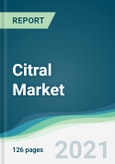The market of citral is expected to drive by increasing demand for citral in consumer goods due to its pleas-ant odor and taste, mainly by food, cosmetics, and personal care industries. It is also used as an active agent in medical fields to cure the breast cancer. Increasing disposable income of the consumers is also driving the growth of the citral market. Increase in disposable income will increase the demand for the consumption goods by the people as income is directly proportional to the consumption expenditures. Recently, the global sales have declined in the consumption sector, but it is expected that in the coming period, the citral market will show the excess production because of more demand than the supply at present (source: WBOC). Eu-rope and China will continue to be the main regions in the consumption sector due to the in-creasing demand for the downstream applications.
The global citral market is segmented by application, by End-users, by insulation type, by product type, and by geography. In geography, the market is sub-segmented into North America, South America, Europe, Middle East and Africa, and Asia Pacific, among them Europe, North America and Asia Pacific are the major regions for the citral market, while the others have relatively low penetration, this gives a potential opportunity for the companies to grow in these regions, mainly in India and Middle East and Africa. For the manufacturing companies, there is a potential growth in the citral market, if they come up new applications of citral through research and development. By End-users, the citral market is segmented into pharmaceuticals, confectionary, cosmetics, food, and others industry. There is an opportunity for the firms to grow in the chemical industry in others’ industry. The market is segmented by product into natural and synthetic Both the segments have the potential to grow in their own way. The synthetic segment has the significant growth opportunities because the natural citral is volatile in nature and less stable. Though, many companies are researching and developing new products for the laundry and detergent sector that happened to be growing after pandemic. Hypoallergic laundry detergents have brought a significant change in the natural citral market, as it is organic, and affordable for the people. Ecos, one of the manufacturers has introduced lemongrass based hypoallergic detergent and has been promoting it in the market
COVID-19 Impact
The pandemic COVID-19 has adversely impacted the citral market, as it hampered both the production and the consumption markets, where in production market, the manufacturing has been hampered due to the lockdowns, and in consumption market, people’s priority has been shifted to their health, and this impacted the demand for goods such as perfumes, cosmetics, and others, and hence, the citral market. On the bright side, the demand for the goods related to hygiene and sanitization has increased, which in turn has increased the demand for the citral market. The manufacturers have shifted their production of citral related goods to the hygienic and sanitization sector, laundry detergents sectors
Recent Developments
Recently, BASF has been increasing its production in Malaysia and Zhejiang NHU new project of citral, which will further increase the competitiveness in the market. This will also impact the price and profits of the companies adversely, as increase in supply would lead to fall in price of the citral in the market. Ecos has been working on the hypoallergic laundry detergents which is a potential market from the growth perspective. Recently, in China, the major domestic company in citral market is Shandong NHU Pharmaceutical Co. Ltd with an account of 80% of the total market, where the price of the natural citral is more than the price of the synthetic citral, because of the BASF explosion which in turn reduced the supply of citral in the China market
APAC to witness lucrative growth
Asia Pacific is expected to have the highest growth in the citral market because of the increasing demand for the consumption goods such as perfumes, cosmetics, cleaners, and so on. An-other reason for the driving the consumption demand in Asia Pacific is the increasing population of this region. In Asia pacific region, the companies have the significant potential to grow by coming up with new innovations of the citral based products. Since, the developing countries, mainly India has been promoting the sustainable environment and people are also preferring to have more organic products, the natural citral market has the potential growth in this region
China is having a significant growth in the citral market, due to the rapid development of the economy, mainly, pharmaceutical, food, health care products and others. With the rapid developments, people’s living standard is improving which in turn would lead to further increase in demand for the citral related products, and much faster than the global average increase.
Segmentation
By product
- Natural
- Synthetic
By Application
- Lemon Essence
- Vitamins
- Menthol
- Others
By End-users
- Food industry
- Cosmetics Industry
- Pharmaceutical industry
- Confectionary Industry
- Others
By Geography
- North America
- USA
- Canada
- Mexico
- South America
- Brazil
- Argentina
- Others
- Europe
- Germany
- Italy
- United Kingdom
- France
- Others
- Middle East and Africa
- Saudi Arabia
- South Africa
- Others
- Asia Pacific
- China
- Japan
- Australia
- India
- Others
Note: This report will be delivered within 3 business days.
Table of Contents
Companies Mentioned
- BASF
- Kuraray
- Teck Soon Hong
- Industrial and Fine Chemicals
- Jiangxi Global Natural Spices
- Rajkeerth
- Kalpsutra Chemicals
- Takasago International Corp
- International Flavours Fragrances
- Alfa Aeesar
- Parchem fine and specialty chemicals








